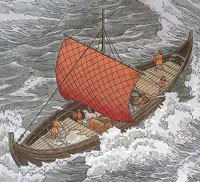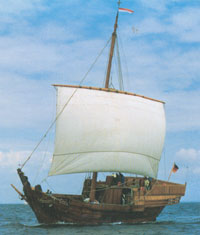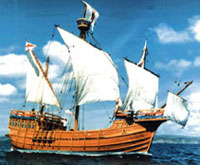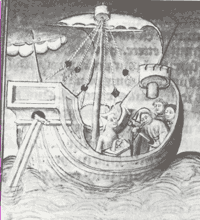|
When man first took to the seas his first concern was to gather fish and other marine wildlife as a source of food . By the time man had established
himself into permanent settlements he was already trading with neighboring groups. This trade at first focused the exchange of his surplus produce for
items he could not obtain locally. As a result, most of the trade conducted was only over very short distances and therefore involved hugging the coast
or following rivers (see inland waterways above). As man became more civilized and came into contact with more distant civilizations and lands he also
acquired a taste for luxury goods to improve his standing economically and socially. These changes led to larger vessels to carry larger cargos and
better navigation techniques which in turn led determined mariners further away from coastal waters out into the open seas. Listed are some of
the most common types of vessels found within the regions of Northwestern Lýthia and Hârn:
|
|
Vessels From Pilot's Almanac
|

|
Nivik:
The Nivik is a large single-masted, square-rigged, merchantmen of the northwest and west of Lýthia. The vessel has a clinker
constructed hull, a steering oar on the starboard quarter and a full orlop, but no main deck. In foul weather a canopy may be erected to
provide protection for the crew. Niviks range in size from 24 feet to 60 feet and can carry up to 120 tuns of goods and crew. The smaller
vessels are typically used as fishing vessels and coastal traders, averaging between 30-42 feet in length; the larger vessels being used for
seagoing trade. Although the dominant trading vessel within Hârnic and Ivinian waters at one time, it is now being supplanted by the Dak
throughout much of western Lýthia.
|

|
Dak:
The Dak is a large flat-bottomed clinker-built bulk cargo vessel that originated in the Shorkyne Gulf area. It has replaced the Nivik as the
dominant cargo vessel in Shorkyne, Emelrene and western Trierzon. It is also making inroads in the Ivinian dominated lands and Hârn.
The Dak was specifically designed to be a bulk carrier since this is the dominant type of cargo available for transshipment within these
regions. The Dak is usually constructed with a stern castle for protection and as a permanent shelter for the ship's officers. In addition,
some Daks also have a forecastle if they are designated for military use or expecting armed conflict. These vessels carry a square-rigged
mast as their only means of propulsion. A significant feature of the Dak is its straight stem and stern posts and the addition of a rudder
to the stern post in lieu of a steering-oar. These vessel are slow and unwieldy but very seaworthy due to their high freeboard. Daks range
in size from 48 feet to 84 feet with the largest carrying up to 543 tuns of cargo and crew.
|

|
Karune:
Although considered a revolutionary design, it is in fact a southern example of the Dak which first appeared in Trierzon and Palithane
within the last thirty years. Its design enables it to handle open seas and longer voyages and like the Dak is also designed to carry bulky
cargoes; however, due to its more sleek design it tends to carry less cargo than a comparably sized Dak. Like the Dak it has a stern mounted
rudder, but usually mounts two or more masts. The rigging is usually mixed square and venyn sails; with the main sail usually being square-
rigged. All of this makes the Karune more maneuverable and faster. As of now, the key production areas for these vessels are Trierzon,
Palithane and Chelemby. Due to their cost, and the secretiveness of the shipwrights who build them, there is only about 60 vessels afloat as
of 720 T. R. A Karune ranges between 60 feet and 96 feet with the largest vessels capable of carrying up to 571 tuns.
|
| |
|
|
A New Vessel For Northwest Lýthia
|

|
Hulc:
The Hulc is a large bulk cargo carrier developed by Emelrene shipwrights within the last two decades; specifically for carrying wine, grain,
lumber and other like materials. Instead of a keel, it has a flat central plank that extends from bow to stern; in addition, it also has no
stern or stem posts. Another unusual feature of its clinker constructed hull is that each successive strake overlaps the one it is attached
to on the inside instead of the outside as in a normal clinker built hull. As can be seen from the illustration, the strakes bend up and end
at the sheer line, usually having some form of collar to hold them in place. The biggest advantage of this design is that there is less drag
on the hull due to its unique clinker construction and it can be built larger than the cog and thus carry more cargo. These vessels will
usually carry one or more masts rigged with square sails and are steered by means of a double steering oar, although some are being
outfitted with stern rudders now. Due to their size the Hulc is neither fast nor maneuverable, but its load capacity makes up for this short
coming. These vessel range in size from 60 feet to well over a hundred feet and can carry loads well over 600 tuns on the largest vessels.
|
|